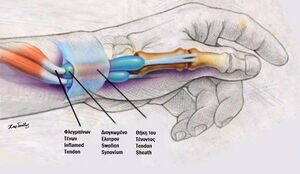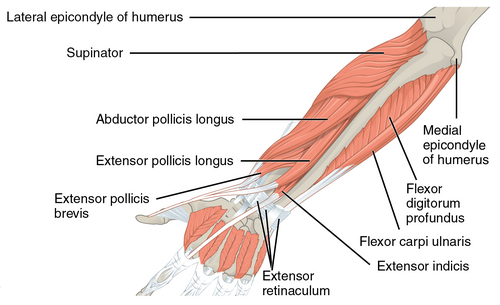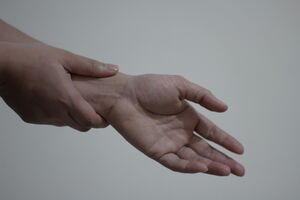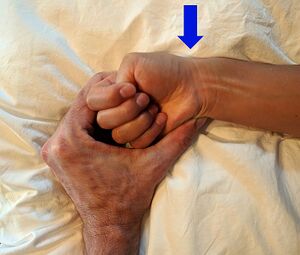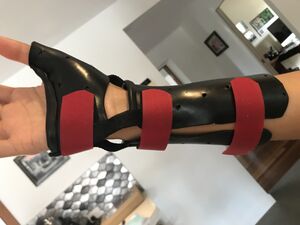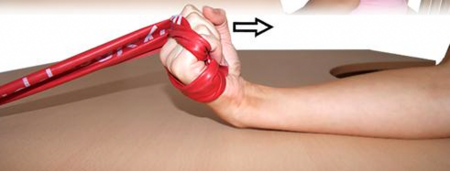De Quervain's Tenosynovitis: Difference between revisions
(adding video code) |
(add kinesio video) |
||
| Line 115: | Line 115: | ||
<u>Kinesio-taping Technique</u> can also be used to decrease pain and improve function.<ref>Kaçmaz İE, Koca A, Basa CD, Zhamilov V, Reisoğlu A. Efficacy of Kinesiologic Taping in de Quervain's Tenosynovitis: Case Series and Review of Literature. Medical Journal of Bakirkoy. 2019 Sep 1;15(3).</ref> | <u>Kinesio-taping Technique</u> can also be used to decrease pain and improve function.<ref>Kaçmaz İE, Koca A, Basa CD, Zhamilov V, Reisoğlu A. Efficacy of Kinesiologic Taping in de Quervain's Tenosynovitis: Case Series and Review of Literature. Medical Journal of Bakirkoy. 2019 Sep 1;15(3).</ref> | ||
{{#ev:youtube|dMH0bHeiRNg|300}}<ref>STRENGTHTAPE®. STRENGTHTAPE® | Kinesiology Tape | De Quervain. Available from: https://youtu.be/n-m9RT7sdUA [last accessed 26/10/2021]</ref> | |||
{{#ev:youtube|n-m9RT7sdUA | |||
</ref> | |||
<u>Therapeutic Ultrasound</u> has also better outcomes in pain reduction and healing. <ref name=":1" /> | <u>Therapeutic Ultrasound</u> has also better outcomes in pain reduction and healing. <ref name=":1" /> | ||
Revision as of 19:59, 26 October 2021
Original Editor - Elizabeth Dallas, Boris Alexandra, Robin Tacchetti
Top Contributors - Wanda van Niekerk, John Winkelhaus, David Cameron, John Fite, Robin Leigh Tacchetti, Robin Tacchetti, Laura Ritchie, Admin, Boris Alexandra, Kim Jackson, Aurelie Canas Perez, Julie Schuermans, Elizabeth Dallas, Lucinda hampton, Redisha Jakibanjar, Corin Arundale, Rachael Lowe, Tarina van der Stockt, Jess Bell, Jorge Rodríguez Palomino, WikiSysop, Arturo Quiroz Marnef, 127.0.0.1, Kai A. Sigel, Claire Knott, Anas Mohamed, Chrysolite Jyothi Kommu, Evan Thomas and Naomi O'Reilly - Corin Arundale, David Cameron, John Fite, Bryan Purkey, John Winkelhaus
Definition/Description[edit | edit source]
De Quervain's Tenosynovitis is a painful inflammation of tendons on the side of the wrist at the base of the thumb. The pain, which is the main complaint, gets worse with the abduction of the thumb, grasping action of the hand, and an ulnar deviation of the wrist. Thickening and swelling can also be present. [1] [2][3][4]
Aetiology
- The most common cause is chronic overuse.
- Activities such as golfing, playing the piano, fly fishing, carpentry, office workers and musicians can lead to chronic overuse injuries.
- The classic patient population is mothers of newborns who are repeatedly lifting a newborn with thumbs radially abducted and wrists going from ulnar to radial deviation.
- Repetitive gripping, grasping or wringing of objects can cause inflammation of the tendons and tendon sheaths which narrows the first dorsal compartment limiting motion of the tendons. If left untreated, the inflammation and progressive narrowing (stenosis) can lead to scarring that further limits thumb motion. [2][3][4]
- DeQuervain's has been attributed to myxoid degeneration (the process in which the connective tissues are replaced by a gelatinous substance) with fibrous tissue deposits and increased vascularity rather than acute inflammation of the synovial lining. It is for this reason that is thought to be tendinosis versus tendonitis.[5] This deposition results in thickening of the tendon sheath, painfully entrapping the abductor pollicis longus and extensor pollicis brevis tendons.
Relevant Clinical Anatomy[edit | edit source]
These tendons include the extensor pollicis brevis (EPB) and the abductor pollicis longus (APL). These muscles are located on the dorsal side of the forearm and go to the lateral side of the thumb through a fibrous-osseous tunnel made of the processus styloideus radii and the extensor retinaculum. [6] [7] The tendon sheaths around the abductor pollicis longus and extensor pollicis brevis pass through the fibro-osseous tunnel located along the radial styloid at the distal wrist.
Extensor pollicis brevis (EPB)
- Origin: ½ dorsal side of the radius, the membrana interossea
- Insertion: base of the proximal phalanx of the thumb
- Function:
- wrist joint: radial abduction
- thumb: extension
- Innervations: N. radialis
- Artery: A. interossea posterior
Abductor pollicis longus (APL)
- Origin: dorsal side of the radius and the ulna, the membrana interossea
- Insertion: base of ossis metacarpi
- Function:
- wrist joint: radial abduction
- thumb: abduction
- Innervations: N. radialis
- Artery: A. interossea posterior
Epidemiology[edit | edit source]
- The estimated prevalence of de Quervain tenosynovitis is about 0.5% in men and 1.3% in women with peak prevalence among those in their forties and fifties.
- It may be seen more commonly in individuals with a history of medial or lateral epicondylitis.
- Bilateral involvement is often reported in new mothers or child care providers in whom spontaneous resolution typically occurs once lifting of the child is less frequent[8]
- In industrial settings, studies have shown a point prevalence of 8% when wrist pain and a positive Finkelstein’s test is present. [2]
Characteristics/Clinical Presentation[edit | edit source]
Examination[edit | edit source]
The evaluation of a patient with signs and symptoms of De Quervain’s Tenosynovitis begins with a thorough history followed by a physical examination:
History[edit | edit source]
- Overuse injury vs acute trauma
- Prior history of symptoms
- Repetitive movements of the upper extremity with work or activities of daily living (ADL)
- Hand dominance
- Pregnant or currently in the post-partum stage
- Pain:
- the primary complaint is radial sided wrist pain (base of thumb and dorsolateral aspect of the wrist near radial styloid process) that radiates up the forearm with grasping or extension of the thumb
- described as a “constant aching, burning, pulling sensation."[9]
- aggravated by repetitive lifting, gripping, or twisting motions of the hand (such as opening a jar lid). [9]
Physical Exam[edit | edit source]
- On palpation, some key, significant findings will be tenderness over the base of the thumb and/or 1st dorsal compartment extensor tendons on the thumb side of the wrist particularly over the radial styloid process[2]
- Swelling in the anatomical snuffbox
- decreased CMC abduction ROM of the 1st digit
- palpable thickening of the extensor sheaths of the 1st dorsal compartment and
- crepitus of the tendons moving from the extensor sheath [10]
- Other possible findings include:
- weakness and paresthesia in the hand.[4]
- The provocative Finkelstein test, in which the thumb is flexed and held inside a fist, and the patient actively clearly deviates the wrist, causes sharp pain along the radial wrist at the first dorsal compartment.[8]
- Other possible findings include:
Non-Surgical Treatment[edit | edit source]
The aim of non-surgical management is to reduce pain and swelling which can include
- Patient education regarding avoiding repetitive or aggravating movements[5]
- Nonsteroidal anti-inflammatory drugs (NSAIDS)Ice/heat packs
- Physical Therapy[11]
- Thumb splinting
- Literature supports the use of a forearm brace including the thumb to reduce ulnar deviation and thumb movement.[5]
- Clinicians do not agree on the frequency and duration of the splint; some think it should be worn continually for four to six weeks; others recommend wearing it only as needed for pain.[3]
- When used a 19% improvement was observed but when they combined it with NSAID’s they found an even bigger improvement of 57%. [12]
- Ultrasound is thought to improve the treatment outcome and can be used as a diagnostic tool in the management of de Quervain’s disease.[13]
- Corticosteroid injection has been reported to provide near-complete relief with one or two injections. The injection is performed into the tendon sheath about 1 cm proximal to the radial styloid where the tendons are palpable.
- If symptoms fail to improve or recur after two corticosteroid injections, operative management is an option. Surgery is usually performed in an outpatient setting. It can entail local, regional, or general anaesthesia.[8]
- Patients with moderate to severe symptoms usually require cortisone injections in combination with splinting.[5]
** For those individuals with persistent symptoms, splinting, systemic anti-inflammatories, and corticosteroid injection are the most frequently utilized non-surgical treatment options.[16][17] [18]
Surgical Treatment[edit | edit source]
- Surgery is rare and is usually for those when non-surgical treatment has failed and the patient experiences persistent inflammation affecting his or her function. The goal of surgery is to open the dorsal compartment covering to make more room for the irritated tendons. The opening allows pressure relief of the tendons, to ultimately restore free tendon gliding.
- Post-operative care is usually limited. A simple dressing or wrap is frequently utilized with no need for complex wound care. Patients are advised to begin early use for activities of daily living and other light activities. Once sutures are removed, usually by two weeks, patients are typically released to resume normal activities. Patients may continue to experience mild swelling and tenderness at the surgical site for a few months.[8]
Physical Therapy Management[edit | edit source]
Ice/Heat Packs - Heat can help relax and loosen tight musculature, and ice can be used to help relieve inflammation of the extensor sheath.
Massage - Deep tissue massage at the thenar eminence can help relax tight musculature that causes pain. . Graston Technique of manual soft tissue mobilization along with the eccentric exercise is also helpful. Graston technique includes breaking down fascia restriction, stretching connective tissue, and promoting a better healing environment.[20]
Stretching - Stretching the thenar eminence muscles into thumb extension and abduction can relax and lengthen this tight musculature that causes pain.[20]
Increasing Strength
- The progression of exercise therapy is as follows:[5]
- isometric
- eccentric
- concentric inner range
- theraputy
- radial nerve glides
Mobilisation
Mobilisation with movement has shown effectiveness in decreasing the pain, improving range of motion, and improving the function of a patient with De-Quervain tenosynovitis. The therapist provides a manual radial glide of the proximal row of carpals, then asked the patient to move her thumb into radial abduction-adduction.[22] Mobilisation with movement performed for 3 sets of 10 repetitions and followed by eccentric hammer curl exercise with theraband and high voltage electrical stimulation has shown effective result after 6 months followup, [23]
Kinesio-taping Technique can also be used to decrease pain and improve function.[24]
Therapeutic Ultrasound has also better outcomes in pain reduction and healing. [20]
Summary[edit | edit source]
Effective management of DeQuervain’s tenosynovitis will involve a highly individualized, impairment driven approach for the patient in question. Early splinting during the acute phase will prevent aggravation of the tissues, and allow the patient to perform activities essential to self-care and employment. The patient will need to be educated on the tissue healing timetables, as well as why it is important to avoid activities that are aggravating to their symptoms.
Once symptoms have decreased to the point that a splint is no longer necessary, the therapist will need to perform a thorough examination and evaluation to determine the residual effects from immobilization. Some losses in ROM may occur, and grade III-IV mobilisations of the radiocarpal, scapholunate, and 1st CMC joint would then be warranted. As the patient nears discharge, education should include a component on the importance of avoiding repetitive motions that could play an aggravating role, or potentially lead to a relapse of the condition.
References[edit | edit source]
- ↑ Thomas Pagonis, Konstantinos Ditsios. Improved Corticosteroid Treatment of Recalcitrant de Quervain Tenosynovitis With a Novel 4-Point Injection Technique. Am J Sports Med 2011 (Level of evidence 2B)
- ↑ 2.0 2.1 2.2 2.3 Ashurst JV, Turco DA, Lieb BE. Tenosynovitis Caused by Texting: An Emerging Disease. JAOA 2010:110(5).
- ↑ 3.0 3.1 3.2 Harvard Women's Health Watch. Harvard Health Publications. Copyright 2010 by President and Fellows of Harvard College. www.healthharvard.edu. Accessed 11/27/11.
- ↑ 4.0 4.1 4.2 Gonzalez-Inglesias J, et al. Differential Diagnosis and Physical Therapy Management of a Patient With Radial Wrist Pain of 6 Months Duration: A Case Report. J Orthop Sports Phys Ther 2010:40(6).
- ↑ 5.0 5.1 5.2 5.3 5.4 Kate Thorn. De Quervain's Tenosynovitis. Physioplus Course. 2021
- ↑ SCHUNKE, M., SCHULTE, E., SCHUMACHER, U., VOLL, M., WESKER, K., Prometheus, Bohn Stafleu van Loghum, Houten, 2005.
- ↑ MEEUSEN, R., Praktijkgids pols- en handletsels, Kluwer editorial, Diegem, 1999.
- ↑ 8.0 8.1 8.2 8.3 Satteson E, Tannan SC. De Quervain Tenosynovitis. InStatPearls [Internet] 2018 Nov 18. StatPearls Publishing.Available from:https://www.ncbi.nlm.nih.gov/books/NBK442005/ (last accessed 31.3.2020)
- ↑ 9.0 9.1 Walker MJ. Manual Physical Therapy Examination and Intervention of a Patient With Radial Wrist Pain: A Case Report. J Orthop Sports Phys Ther 2004:34(12).
- ↑ Anderson M, Tichenor C. A Patient With De Quervain’s Tenosynovitis: A Case Report Using an Australian Approach to Manual Therapy. Phys Ther 1994:74(4).
- ↑ Földvári-Nagy L, Takács J, Hetthéssy JR, Mayer ÁA, Szakács N, Szávin-Pósa Á, Lenti K. Treatment of De Quervain's tendinopathy with conservative methods. Orvosi Hetilap. 2020 Mar 1;161(11):419-24.
- ↑ A.P. Weiss, E. Akelman, M. Tabatabai; Treatment of de Quervain's disease;J Hand Surg, 19A (1994), pp. 595–598
- ↑ Hajder E., The role of ultrasound-guided triamcinolone injection in the treatment of de Quervain’s disease: treatment and diagnostic tool?, Chirurgie de la main, 2013, vol.6, p. 403-7,( level of evidence: 2B).
- ↑ James D. McDermott, Ultrasound-guided injections for de Querain’s tenosynovitis, Clin. Othop. Relat. Res., 2012, vol. 7, p. 1925-1931,( level of evidence: 4.)
- ↑ Kume K., In de Quervain’s with a separate EPB compartment, ultrasound-guided steroid injection is more effective than a clinical injection technique: a prospective open-label study, Journal of hand surgery European volume, 2012, vol. 6, p.523-7,( level of evindence: 1B).
- ↑ Cavaleri R, Schabrun SM, Te M, Chipchase LS. Hand therapy versus corticosteroid injections in the treatment of de Quervain's disease: A systematic review and meta-analysis. Journal of Hand Therapy. 2016 Jan 1;29(1):3-11.
- ↑ Abi-Rafeh J, Kazan R, Safran T, Thibaudeau S. Conservative management of de Quervain stenosing tenosynovitis: review and presentation of treatment algorithm. Plastic and reconstructive surgery. 2020 Apr 15;146(1):105-26.
- ↑ Başar B, Aybar A, Basar G, Başar H. The effectiveness of corticosteroid injection and splint in diabetic de Quervain's tenosynovitis patients: A single-blind, randomized clinical consort study. Medicine. 2021 Sep 3;100(35).
- ↑ Dequervain's Tenosynovitis. Available from: http://www.youtube.com/watch?v=roGXYRnUJZQ [last accessed 28/03/13]
- ↑ 20.0 20.1 20.2 Goel R, Abzug JM. De Quervain's tenosynovitis: a review of the rehabilitative options. Hand. 2015 Mar;10(1):1-5.
- ↑ https://www.youtube.com/watch?v=eRCE501w0-s&t=1s
- ↑ Backstrom KM. Mobilization with movement as an adjunct intervention in a patient with complicated de Quervain's tenosynovitis: a case report. The Journal of orthopaedic and sports physical therapy. 2002 Mar;32(3):86-94.
- ↑ Rabin A, Israeli T, Kozol Z. Physiotherapy Management of People Diagnosed with de Quervain's Disease: A Case Series. Physiotherapy Canada. 2015 Aug;67(3):263-7.
- ↑ Kaçmaz İE, Koca A, Basa CD, Zhamilov V, Reisoğlu A. Efficacy of Kinesiologic Taping in de Quervain's Tenosynovitis: Case Series and Review of Literature. Medical Journal of Bakirkoy. 2019 Sep 1;15(3).
- ↑ STRENGTHTAPE®. STRENGTHTAPE® | Kinesiology Tape | De Quervain. Available from: https://youtu.be/n-m9RT7sdUA [last accessed 26/10/2021]
- Pages with broken file links
- Assessment
- Hand
- Wrist
- Special Tests
- Tendons
- Texas State University EBP Project
- Vrije Universiteit Brussel Project
- EIM Residency Project
- Musculoskeletal/Orthopaedics
- Primary Contact
- Sports Medicine
- Sports Injuries
- Conditions
- Wrist - Conditions
- Hand - Conditions
- Hand - Special Tests
- Wrist - Special Tests
- Physioplus Course
- Course Pages
